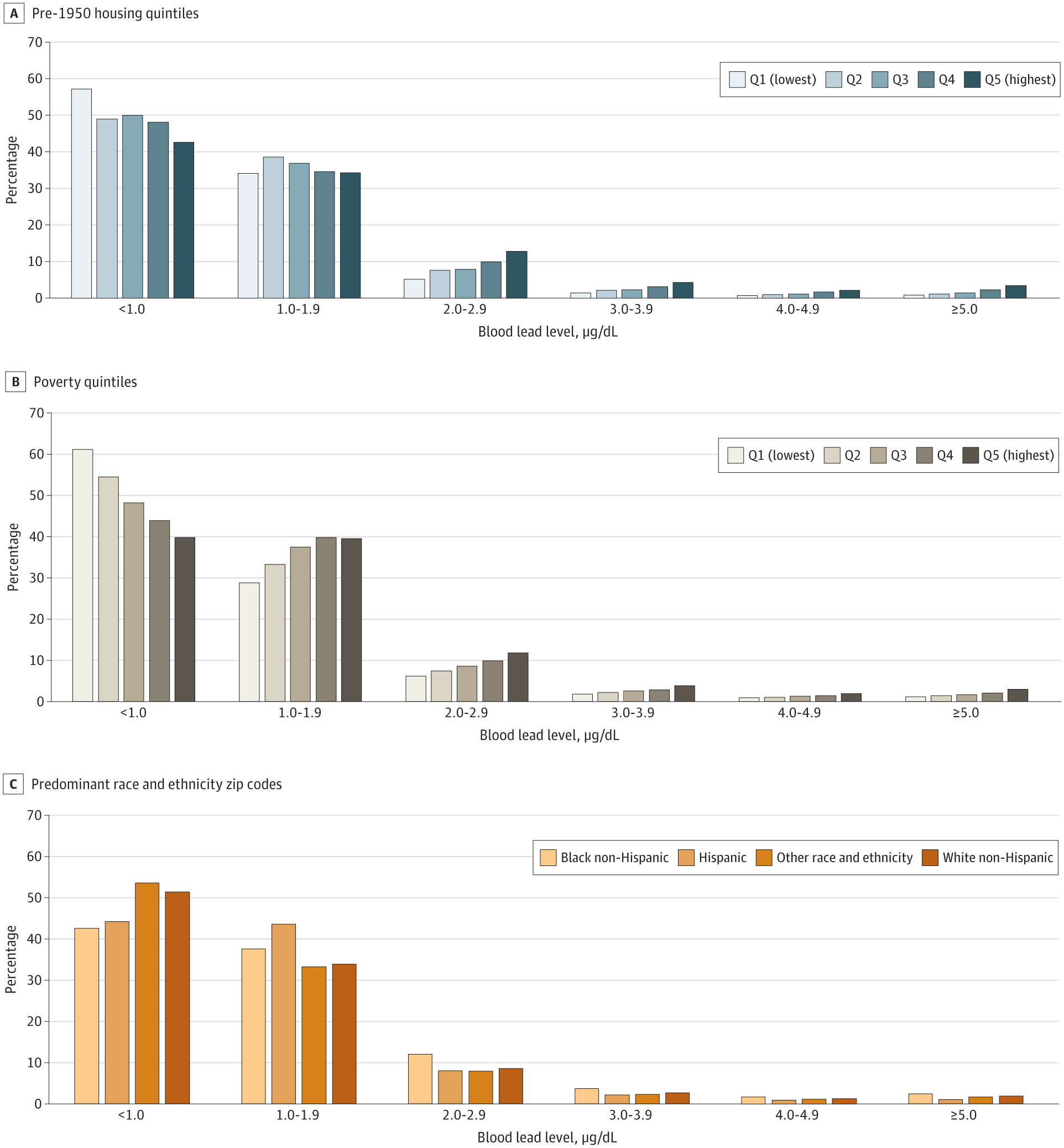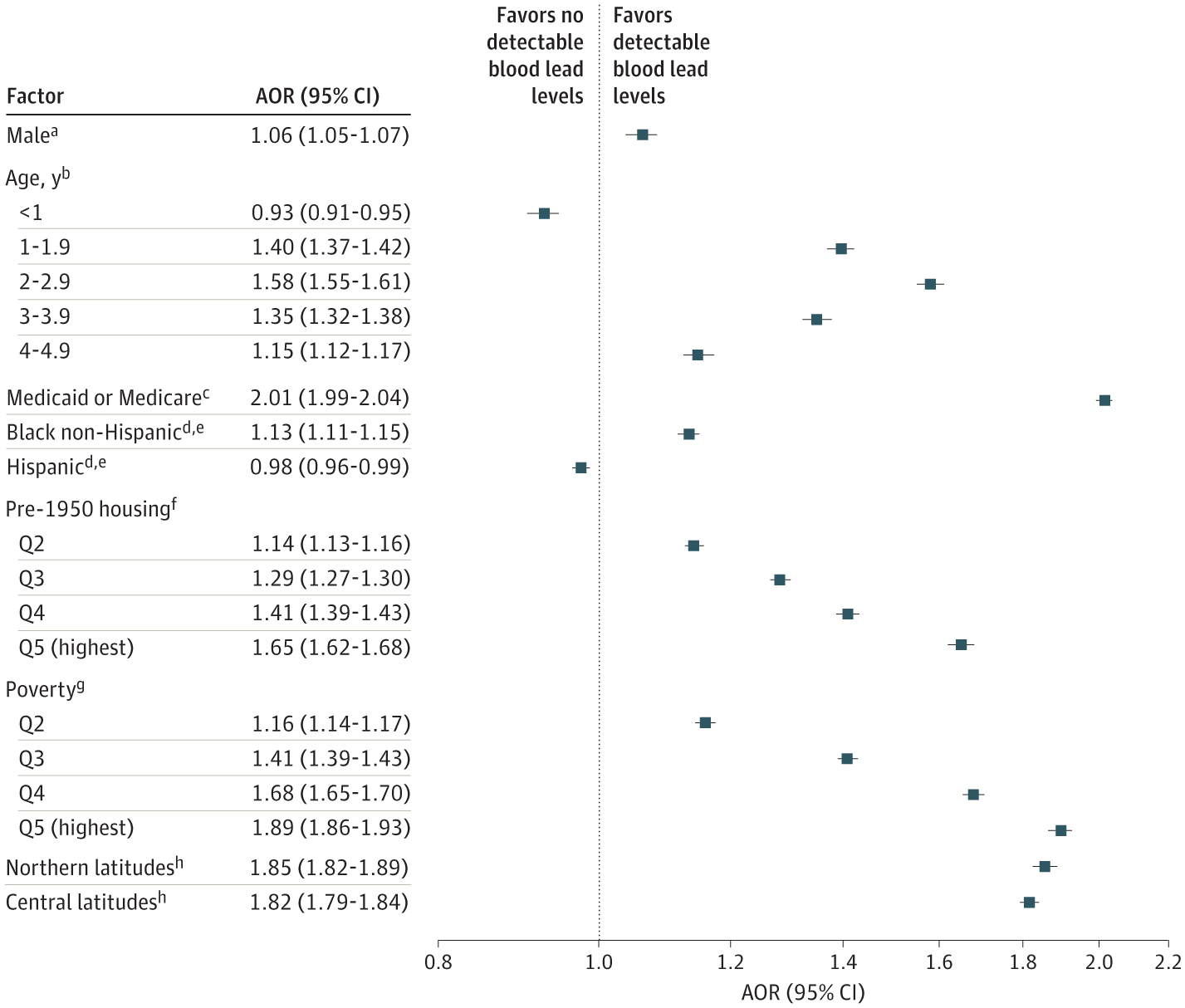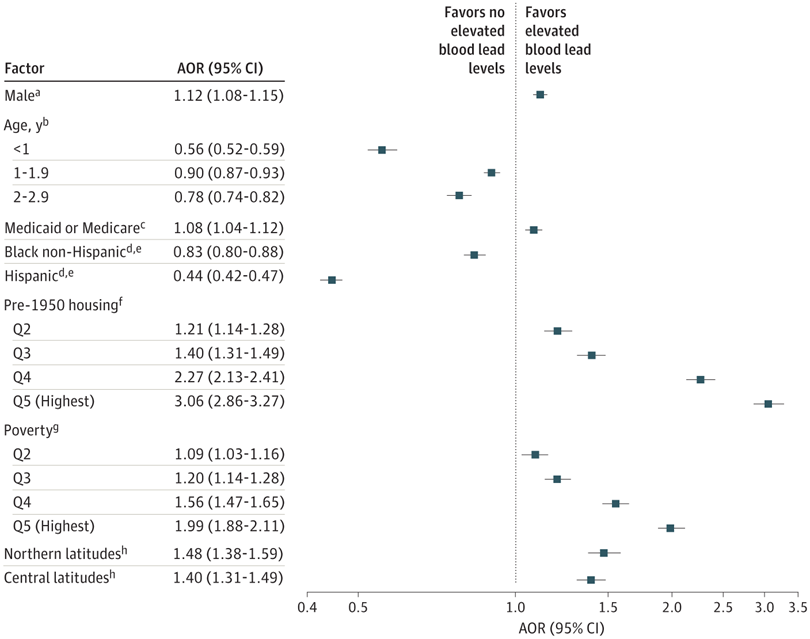
Original Investigation
September 27, 2021
Individual- and Community-Level Factors Associated With Detectable and Elevated Blood Lead Levels in US Children
Results From a National Clinical Laboratory
Marissa Hauptman, MD, MPH1,2; Justin K. Niles, MA3; Jeffrey Gudin, MD3,4; et al Harvey W. Kaufman, MD3
Author Affiliations Article Information
JAMA Pediatr. 2021;175(12):1252-1260. doi:10.1001/jamapediatrics.2021.3518
Key Points
Question What individual- and community-level factors are associated with detectable blood lead levels (BLLs) in children?
Findings This cross-sectional study linking Quest Diagnostics childhood lead testing and US Census data captured individual- and community-level disparities in lead exposure from October 2018 through February 2020. In adjusted models, the proportion of children with detectable (≥1.0 μg/dL) and elevated (≥5.0 μg/dL) BLLs increased significantly among those with public insurance and for progressive quintiles of community pre-1950s housing and poverty.
Meaning Similar individual- and community-level disparities were seen among children with detectable BLLs and those with elevated BLLs.
Abstract
Importance No safe level of exposure to lead has been identified.
Objective To evaluate individual- and community-level factors associated with detectable and elevated blood lead levels (BLLs) in children.

Figure 1. Children With Detectable or Elevated Blood Lead Levels by State
Design, Setting, and Participants This cross-sectional, retrospective study analyzed deidentified results from blood lead tests performed at a large clinical laboratory from October 1, 2018, to February 29, 2020. Participants were 1 141 441 children younger than 6 years living in all 50 US states and the District of Columbia who underwent blood lead testing during the study period. Children who underwent lead testing of unknown source and those with elevated BLLs who received capillary blood lead testing without confirmatory venous testing were excluded.
Exposures Individual demographic categories included sex, age, and insurance type; community-level demographic categories included pre-1950s housing, poverty, predominant race and ethnicity, and geographical regions.

Figure 2. Distribution of Blood Lead Levels Based on Risk Factor Quintiles Assessed by Zip Code
Main Outcomes and Measures Proportions of children with detectable (≥1.0 μg/dL) and elevated (≥5.0 μg/dL) BLLs, by exposure category.

Figure 3. Factors Associated With Detectable Blood Lead Levels in Children Younger Than 6 Years: Multivariable Model

Results Of the 1 141 441 children (586 703 boys [51.4%]; mean [SD] age, 2.3 [1.4] years) in the study, more than half of the children tested (576 092 [50.5%; 95% CI, 50.4%-50.6%]) had detectable BLLs, and 21 172 children (1.9% [95% CI, 1.8%-1.9%]) had BLLs of 5.0 μg/dL or more. In multivariable analyses, children with public insurance had greater odds of having detectable BLLs (adjusted odds ratio [AOR], 2.01 [95% CI, 1.99-2.04]) and elevated BLLs (AOR, 1.08 [95% CI, 1.04-1.12]). The proportion of children with detectable and elevated BLLs increased significantly for progressive pre-1950s housing and poverty quintiles (P < .001). The odds of detectable BLLs were significantly higher among children in the highest vs lowest quintile of pre-1950s housing (AOR, 1.65 [95% CI, 1.62-1.68]) and of poverty (AOR, 1.89 [95% CI, 1.86-1.93]). A similar association was found for those with elevated BLLs, with an AOR of 3.06 (95% CI, 2.86-3.27) for the highest vs lowest quintile of pre-1950 housing and 1.99 (95% CI, 1.88-2.11) for the highest quintile of poverty. Children residing in zip codes with predominantly Black non-Hispanic and non-Latinx populations had higher odds of detectable BLLs (AOR, 1.13 [95% CI, 1.11-1.15]) but lower odds for elevated BLL (AOR, 0.83 [95% CI, 0.80-0.88]).
Conclusions and Relevance This study suggests that, despite progress in reducing pediatric lead exposure, substantial individual- and community-level disparities persist.
https://jamanetwork.com/journals/jamapediatrics/article-abstract/2784260

Comments